Sweet Corn IPM Newsletter No. 8- August 21, 2020
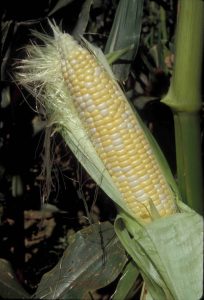
Sweet Corn IPM Newsletter No. 8 – August 21, 2020
Click on photos to enlarge.
CORN EARWORM COUNTS LOWER, STILL A THREAT TO SILKING CORN
Fall Armyworm Counts Remain High, Despite Cooler Night Temperatures
SITUATION
Another dry week for most fields. Irrigation has helped keep corn quality high, despite the lack of rain. Cooler night temperatures should slow development and spread out maturity on later ripening fields. Cooler nights can also reduce insect activity; we generally saw lower moth counts this week, but populations were still high enough to warrant protecting silks in nearly all fields.
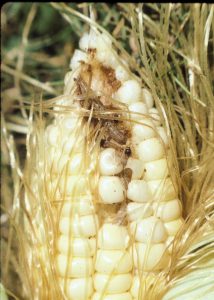
European corn borer:
Larval feeding injury was not over the 15% control threshold for pre-silking corn at any location scouted this week. Moth counts were higher at many sites, and over the weekly threshold of five for silking corn in Poland Spring and Sabattus, indicating a second generation is now emerging.
Corn earworm:

Although moth captures were down from last week’s season high numbers, counts were still high enough to warrant a tight spray interval on silking corn at most locations. A three-day spray interval for silking corn was recommended at one Cape Elizabeth site. A four-day interval was recommended in Auburn, Biddeford, Bowdoinham, Dayton, New Gloucester, Poland Spring, Wayne, Wells and one Cape Elizabeth site. A five-day spray interval was recommended in Lewiston, Monmouth, Sabattus and one Wells site. A six-day spray interval was recommended in Corinth.
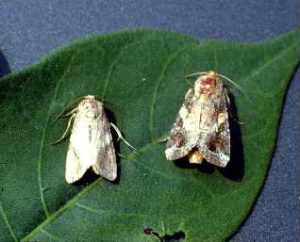
Fall armyworm (FAW):
Moth captures were generally lower this week, but still high enough to recommend protection for silking corn not currently under a spray interval for corn earworm. Counts exceeded the three-per-week threshold for silking corn in: Auburn, Biddeford, Cape Elizabeth, Dayton, Monmouth, New Gloucester, Oxford, Poland Spring, Wayne and Wells. Only the Oxford site was not under a spray interval for corn earworm, so a spray for FAW on silking corn was recommended. Fall armyworm larval feeding damage on pre-silking corn exceeded the 15% threshold in Biddeford, Cape Elizabeth, Dayton, Oxford and Poland Spring.
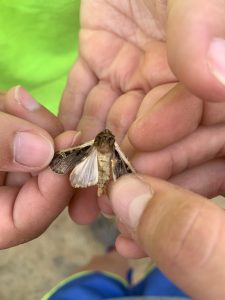
Western Bean Cutworm:
Moths counts were much lower at most locations this week, but still at threatening levels in some sites, including; Auburn (1), Biddeford (2), Bowdoinham (1) Cape Elizabeth (1), Dayton (6), New Gloucester (6), Oxford (6), Sabattus (3), Wayne (8) and Wells (10). All locations, except Oxford, are spraying for corn earworm, which should protect corn from western bean cutworm.
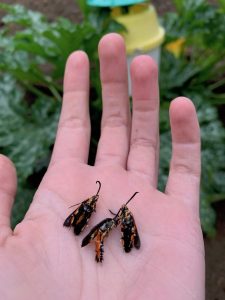
Squash vine borer:
Counts were low this week; Biddeford (1), Oxford (1) and Wells (1). None of the sites were over the threshold of five moths per week, so no sprays were recommended.
Spotted wing drosophila:

Very high traps counts at nearly all locations this week, indicate a very high threat level for any ripening fruit remaining in berry fields. Growers should maintain a tight, regular (5-7 day) spray schedule to prevent larvae from infesting fruit. For more information visit our website: Highmoor Farm News Blog
Sincerely,
David T. Handley
Vegetable and Small Fruit Specialist
Highmoor Farm Pest Mgmt. Unit
P.O. Box 179 17 Godfrey Drive
52 U.S. Route 202 Orono, ME 04473
Monmouth, ME 04259 1.800.287.0279
207.933.2100
| Location | CEW
Moths |
ECB
Moths |
FAW
Moths |
%Feeding
Damage |
Recommendations / Comments |
|---|---|---|---|---|---|
| Auburn | 17 | 0 | 35 | 4-day spray interval for all silking corn | |
| Biddeford | 12 | 2 | 41 | 17% | 4-day spray interval for all silking corn |
| Bowdoinham | 21 | 3 | 38 | 4-day spray interval for all silking corn | |
| Cape Elizabeth I | 17 | 0 | 20 | 4-day spray interval for all silking corn | |
| Cape Elizabeth II | 109 | 3 | 15 | 25% | 3-day spray interval for all silking corn |
| Charleston | 0 | 0 | 0 | No spray recommended | |
| Corinth | 2 | 0 | 0 | 1% | 6-day spray interval for all silking corn |
| Dayton I | 46 | 4 | 41 | 0% | 4-day spray interval for all silking corn |
| Dayton I | 17 | 3 | 71 | 21% | 4-day spray interval for all silking corn |
| Lewiston | 7 | 0 | 0 | 5-day spray interval for all silking corn | |
| Levant | 1 | 0 | 0 | 1% | No spray recommended |
| Monmouth | 4 | 3 | 12 | 5-day spray interval for all silking corn | |
| New Gloucester | 24 | 0 | 120 | 3% | 4-day spray interval for all silking corn |
| Oxford | 1 | 0 | 43 | 16% | One spray on silking and pre-silking corn for FAW |
| Palmyra | 0 | 0 | 0 | No spray recommended | |
| Poland Spring | 12 | 34 | 17 | 18% | 4-day spray interval for all silking corn |
| Sabattus | 7 | 10 | 5-day spray interval for all silking corn | ||
| Wayne | 51 | 2 | 41 | 9% | 4-day spray interval for all silking corn |
| Wells I | 7 | 0 | 18 | 5-day spray interval for all silking corn | |
| Wells II | 20 | 0 | 12 | 4-day spray interval for silking corn |
CEW: Corn earworm (Only fresh silking corn should be sprayed for this insect.)
ECB: European corn borer
FAW: Fall armyworm
| Moths caught per week | Moths caught per night | Spray interval |
|---|---|---|
| 0.0 to 1.4 | 0.0 to 0.2 | No spray |
| 1.5 to 3.5 | 0.3 to 0.5 | Spray every 6 days |
| 3.6 to 7.0 | 0.6 to 1.0 | Spray every 5 days |
| 7.1 to 91 | 1.1 to 13.0 | Spray every 4 days |
| More than 91 | More than 13 | Spray every 3 days |
Thresholds apply only to corn with exposed fresh silk. Lengthen spray intervals by one day if the maximum daily temperature is less than 80°F.
European Corn Borer Thresholds
Whorl stage: 30% or more of plants scouted show injury.
Pre-tassel-silk: 15% or more of plants scouted show injury.
Silk: 5 or more moths caught in pheromone traps in one week.
IPM Web Pages:
Where brand names or company names are used, it is for the reader’s information. No endorsement is implied nor is any discrimination intended against other products with similar ingredients. Always consult product labels for rates, application instructions and safety precautions. Users of these products assume all associated risks.
The University of Maine is an equal opportunity/affirmative action institution.
